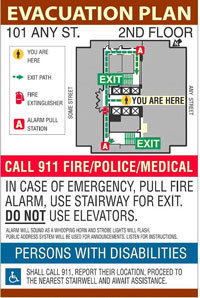|
| |
Evacuation
|
-
 Each area of the premise has specific evacuation procedures Each area of the premise has specific evacuation procedures
- List fire Marshall for each area
- show evacuation diagram
- Provide
general instructions such as stay calm, leave everything behind,
move quickly but safely
- On file there should be a list of person
who need assistance when the first responders arrive.
Emergency Action Plan
An emergency action plan (EAP) is a
written document required by particular
OSHA standards. [29 CFR 1910.38(a)] The
purpose of an EAP is to facilitate and
organize employer and employee actions
during workplace emergencies. Well
developed emergency plans and proper
employee training (such that employees
understand their roles and
responsibilities within the plan) will
result in fewer and less severe employee
injuries and less structural damage to
the facility during emergencies. A
poorly prepared plan, likely will lead
to a disorganized evacuation or
emergency response, resulting in
confusion, injury, and property damage.
Minimum Requirements
Putting together a
comprehensive emergency action
plan that deals with those
issues specific to your worksite
is not difficult. It involves
taking what was learned from
your workplace evaluation and
describing how employees will
respond to different types of
emergencies, taking into account
your specific worksite layout,
structural features, and
emergency systems.
Develop & Implement
an EAP
Drafting an emergency action
plan (EAP) is not enough to
ensure the safety of your
employees. When an evacuation is
necessary, you will need
responsible, trained individuals
who can supervise and coordinate
activities to ensure a safe and
successful evacuation.
Evacuation Elements
A disorganized evacuation can
result in confusion, injury, and
property damage.
Fight or Flee?
A fire is the most common
type of emergency for which
small businesses must plan.
Evacuation plans that designate
or require some or all of the
employees to fight fires with
portable fire extinguishers
increase the level of complexity
of the plan and the level of
training that must be provided
employees.
Shelter-in-Place
Chemical, biological, or
radiological contaminants may be
released into the environment in
such quantity and/or proximity
to a place of business that it
is safer to remain indoors
rather than to evacuate
employees.
Fire, Rescue,
Medical Services
Although most of us quickly
move away from the hazardous
environments created during
emergency situations, a group of
dedicated and well-trained
professional emergency
responders and medical service
personnel are tasked with
containing and mitigating these
incidents, rescuing individuals
at-risk, and providing medical
assistance to the injured.
Reporting
Emergencies
Employees must know how to
report emergencies. Some use
internal telephone numbers,
intercom, or public address
systems to notify other
employees. It is important for
employees to also notify the
proper authorities such as fire,
medical, or rescue services, if
your company relies on this type
of assistance during an
emergency.
Emergency Standards
How do I evaluate my workplace to
comply with OSHA's emergency
standards?
The best way to protect yourself
and others is to prepare for an
emergency before it happens by doing
a thorough assessment of the
workplace. Think about possible
emergency situations and evaluate
your workplace to see if it is
sufficiently prepared in the
following areas:
Design and
Construction Requirements for
Exit Routes
This section contains
requirements for the design and
construction of exit routes. It
also addresses the capacity,
height and width of exit routes,
and finally, it sets forth
requirements for exit routes
that are outside a building. [29
CFR 1910.36]
Emergency Action
Plans (EAP)
An emergency action plan (EAP)
is a written document required
by particular OSHA standards.
The purpose of an EAP is to
facilitate and organize employer
and employee actions during
workplace emergencies. [29 CFR
1910.38]
Fire Prevention
Plans (FPP)
The purpose of the fire
prevention plan is to prevent a
fire from occurring in a
workplace. It describes the fuel
sources (hazardous or other
materials) on site that could
initiate or contribute both to
the spread of a fire, as well as
the building systems, such as
fixed fire extinguishing systems
and alarm systems, in place to
control the ignition or spread
of a fire. [29 CFR 1910.39]
Portable Fire
Extinguishers
Workplace fires and
explosions kill hundreds and
injure thousands of workers each
year. One way to limit the
amount of damage due to such
fires is to make portable fire
extinguishers an important part
of your fire prevention program.
[29 CFR 1910.157]
Fixed Extinguishing
Systems
Fixed fire
extinguishing/suppression
systems are commonly used to
protect areas containing
valuable or critical equipment
such as data processing rooms,
telecommunication switches, and
process control rooms. [29 CFR
1910.160]
Fire Detection
Systems
Automatic fire detection
systems, when combined with
other elements of an emergency
response and evacuation plan,
can significantly reduce
property damage, personal
injuries, and loss of life from
fire in the workplace. [29 CFR
1910.164]
Employee Alarm
Systems
The purpose of the employee
alarm systems standard is to
reduce the severity of workplace
accidents and injuries by
ensuring that alarm systems
operate properly and procedures
are in place to alert employees
to workplace emergencies. [29
CFR 1910.165]
|
|
 Tree
of Life - Human Resources Self-service Intranet
Tree
of Life - Human Resources Self-service Intranet

 Each area of the premise has specific evacuation procedures
Each area of the premise has specific evacuation procedures